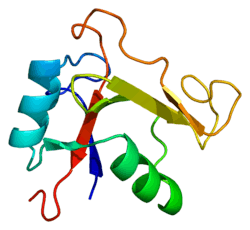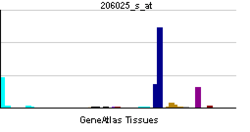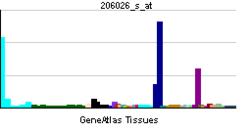TSG-6
Tumor necrosis factor-inducible gene 6 protein also known as TNF-stimulated gene 6 protein or TSG-6 is a protein[3] that in humans is encoded by the TNFAIP6 (tumor necrosis factor, alpha-induced protein 6) gene.[4][5]
TSG-6 is a 30 kDa secreted protein that contains a hyaluronan-binding LINK domain a and thus is a member of the hyaluronan-binding protein family, also called hyaladherins. The hyaluronan-binding domain is known to be involved in extracellular matrix stability and cell migration. This protein has been shown to form a stable, covalent complex with inter-alpha-inhibitor (IαI), and thus enhance the serine protease inhibitory activity of IαI, which is important in the protease network associated with inflammation. The expression of this gene can be induced by a number of signalling molecules, principally tumor necrosis factor α (TNF-α) and interleukin-1 (IL-1). The expression can also be induced by mechanical stimuli in vascular smooth muscle cells, and is found to be correlated with proteoglycan synthesis and aggregation.[5]
TSG-6 also interacts with a plethora of matrix associated molecules, such an aggrecan, versican, thrombospondin (1&2), pentraxin-3 and fibronectin.
References
Further reading
- Milner CM, Day AJ (2004). "TSG-6: a multifunctional protein associated with inflammation.". J. Cell. Sci. 116 (Pt 10): 1863–73. doi:10.1242/jcs.00407. PMID 12692188.
- Fries E, Kaczmarczyk A (2004). "Inter-alpha-inhibitor, hyaluronan and inflammation.". Acta Biochim. Pol. 50 (3): 735–42. PMID 14515153.
- Milner CM, Higman VA, Day AJ (2006). "TSG-6: a pluripotent inflammatory mediator?". Biochem. Soc. Trans. 34 (Pt 3): 446–50. doi:10.1042/BST0340446. PMID 16709183.
- Wisniewski HG, Burgess WH, Oppenheim JD, Vilcek J (1994). "TSG-6, an arthritis-associated hyaluronan binding protein, forms a stable complex with the serum protein inter-alpha-inhibitor.". Biochemistry. 33 (23): 7423–9. doi:10.1021/bi00189a049. PMID 7516184.
- Klampfer L, Lee TH, Hsu W, et al. (1994). "NF-IL6 and AP-1 cooperatively modulate the activation of the TSG-6 gene by tumor necrosis factor alpha and interleukin-1.". Mol. Cell. Biol. 14 (10): 6561–9. PMC 359186
 . PMID 7935377.
. PMID 7935377.
- Wisniewski HG, Hua JC, Poppers DM, et al. (1996). "TNF/IL-1-inducible protein TSG-6 potentiates plasmin inhibition by inter-alpha-inhibitor and exerts a strong anti-inflammatory effect in vivo.". J. Immunol. 156 (4): 1609–15. PMID 8568267.
- Kohda D, Morton CJ, Parkar AA, et al. (1996). "Solution structure of the link module: a hyaluronan-binding domain involved in extracellular matrix stability and cell migration.". Cell. 86 (5): 767–75. doi:10.1016/S0092-8674(00)80151-8. PMID 8797823.
- Parkar AA, Kahmann JD, Howat SL, et al. (1998). "TSG-6 interacts with hyaluronan and aggrecan in a pH-dependent manner via a common functional element: implications for its regulation in inflamed cartilage.". FEBS Lett. 428 (3): 171–6. doi:10.1016/S0014-5793(98)00523-7. PMID 9654129.
- Lee RT, Yamamoto C, Feng Y, et al. (2001). "Mechanical strain induces specific changes in the synthesis and organization of proteoglycans by vascular smooth muscle cells.". J. Biol. Chem. 276 (17): 13847–51. doi:10.1074/jbc.M010556200. PMID 11278699.
- Nentwich HA, Mustafa Z, Rugg MS, et al. (2002). "A novel allelic variant of the human TSG-6 gene encoding an amino acid difference in the CUB module. Chromosomal localization, frequency analysis, modeling, and expression.". J. Biol. Chem. 277 (18): 15354–62. doi:10.1074/jbc.M110765200. PMID 11854277.
- Getting SJ, Mahoney DJ, Cao T, et al. (2003). "The link module from human TSG-6 inhibits neutrophil migration in a hyaluronan- and inter-alpha -inhibitor-independent manner.". J. Biol. Chem. 277 (52): 51068–76. doi:10.1074/jbc.M205121200. PMID 12401803.
- Strausberg RL, Feingold EA, Grouse LH, et al. (2003). "Generation and initial analysis of more than 15,000 full-length human and mouse cDNA sequences.". Proc. Natl. Acad. Sci. U.S.A. 99 (26): 16899–903. doi:10.1073/pnas.242603899. PMC 139241
 . PMID 12477932.
. PMID 12477932.
- Anderson NL, Polanski M, Pieper R, et al. (2004). "The human plasma proteome: a nonredundant list developed by combination of four separate sources.". Mol. Cell Proteomics. 3 (4): 311–26. doi:10.1074/mcp.M300127-MCP200. PMID 14718574.
- Gerhard DS, Wagner L, Feingold EA, et al. (2004). "The status, quality, and expansion of the NIH full-length cDNA project: the Mammalian Gene Collection (MGC).". Genome Res. 14 (10B): 2121–7. doi:10.1101/gr.2596504. PMC 528928
 . PMID 15489334.
. PMID 15489334.
- Sanggaard KW, Karring H, Valnickova Z, et al. (2005). "The TSG-6 and I alpha I interaction promotes a transesterification cleaving the protein-glycosaminoglycan-protein (PGP) cross-link.". J. Biol. Chem. 280 (12): 11936–42. doi:10.1074/jbc.M409016200. PMID 15653696.
- Blundell CD, Almond A, Mahoney DJ, et al. (2005). "Towards a structure for a TSG-6.hyaluronan complex by modeling and NMR spectroscopy: insights into other members of the link module superfamily.". J. Biol. Chem. 280 (18): 18189–201. doi:10.1074/jbc.M414343200. PMID 15718240.
- Mindrescu C, Le J, Wisniewski HG, Vilcek J (2005). "Up-regulation of cyclooxygenase-2 expression by TSG-6 protein in macrophage cell line.". Biochem. Biophys. Res. Commun. 330 (3): 737–45. doi:10.1016/j.bbrc.2005.03.040. PMID 15809059.
PDB gallery |
|---|
|
| 1o7b: REFINED SOLUTION STRUCTURE OF THE HUMAN TSG-6 LINK MODULE |
| 1o7c: SOLUTION STRUCTURE OF THE HUMAN TSG-6 LINK MODULE IN THE PRESENCE OF A HYALURONAN OCTASACCHARIDE |
|
|



 . PMID 1730767.
. PMID 1730767. . PMID 7935377.
. PMID 7935377. . PMID 12477932.
. PMID 12477932. . PMID 15489334.
. PMID 15489334.
